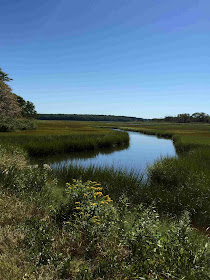By Beth Sullivan
By now I hope you
have heard the news, read the press releases, or have noted the
fireworks. Achieving national accreditation is a huge milestone.
Being able to
display that logo on our website reflects so much effort and
commitment by a dedicated group of volunteers who sacrificed the
better part of the last couple of years reaching for this. And the
actual planning and preparation began in 2005, if not earlier.
A look in the mirror to start
First was the
assessment of the organization, a self -assessment, like looking
into all the corners, stripping off the dust covers and really taking
a close look at where we stood when held up to the Land Trust
Alliance’s (LTA) Standards and Practices. Yikes, it’s worse
than getting into a bathing suit in February.
 |
| Avalonia protects varied habitats from shore to inland forest and all in between. |
Take a look at the
LTA website and try to read the Standards and Practices. Chapter by
chapter, bullet point by bullet point, it lays out the standards of
excellence that are expected in all areas of a land conservation
organization. There is so much more to the formalities of
governance than one tree hugger could imagine. There are polices,
practices, and charters for each standing committee: Governance,
Finance, Personnel, Development, Acquisition, and Stewardship. Each
Town committee has a charter to follow with goals, objectives and
deliverables.
 |
| Education about our irreplaceable resources is part of our mission. |
Over the next period
the organization took each point and answered the questions about how
well it measured up to expectations. In very many ways we were doing
great. As is the case with just about anything though,
documentation is the crux of the whole thing…if it isn’t
documented, you can’t prove it is done. So the next years followed
in making sure all our processes and procedures, things we have been
doing right, were properly documented for the long term. It is
quite an eye opening experience to put all the great work that
has happened in nearly a half century, into organized files,
digitized, prioritized and able to be looked at and approved. Some
folks were great at the finances part. Others understood the
organizational guidelines. Others of us worked to make sure all our
property documentation was in order and all knew, in no uncertain
terms, our responsibilities as stewards of the land.
 |
| Fleeting beauty should be accessible to all. Photograph by Rick Newton. |
A regional land trust
Also remember that
Avalonia is a regional Land Trust, not just dealing with one town
with a few properties, but properties in eight southeastern CT towns
and over 3500 acres. And it has been in existence for almost 50
years. The times have changed; the standards and practices of working
with land and donors has changed. Laws have changed. Everything was
reviewed for the future.
 |
| Our properties protect cultural aspects of human history on the land. |
We all sure learned
a lot. For the last two years, a dedicated core of people,
spear headed by a few who deserve halos, shed blood, sweat, and
tears to make sure every one of those bullet points was answered.
And if there were any omissions or deficiencies, plans were made and
policies enacted to make sure, going forward, that we would be
compliant every step of the way.
 |
| Preserve space for future generations to enjoy and learn from. |
Again a comparison:
it was like taking a well-loved but somewhat over grown and over
stuffed house, tossing everything on the floor and bit by bit
examining, sorting, and reorganizing within a new and efficient
structure that will help us forward. By last fall, the giant binder
with all the organizational proof and plans was turned over to the
LTA judges. They poured over it, bit by bit, called with
questions, clarified and verified.
The reward was ever
so sweet: By mid-February the verdict was in; the call came to our
BOD first and announced to all on Feb 22. Avalonia Land
Conservancy had achieved Accreditation by the very strict standards
of the Land Trust Alliance.
 |
| Stewardship is at the heart of our mission. Photograph by Rick Newton. |
Our members, donors,
and supporters will know that we are on a solid footing, and in a
very good place, as we plan for our next 50 years and beyond.
Thank you to the leaders and every individual who helped get us to
this point. It takes a village to protect our precious land.
Photographs by Beth
Sullivan unless otherwise indicated.
























